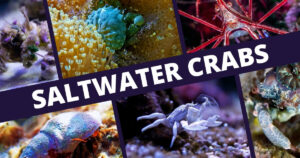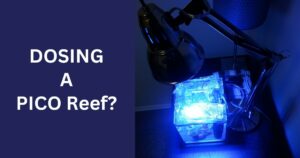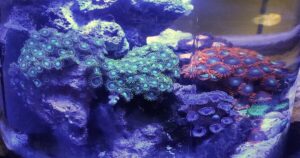The balance of nutrients and elements can be the difference between a flourishing reef and a tank full of problems. I’ll explain how often you should test water parameters in your pico reef but with a twist.
Instead of the usual focus on testing the tank water, I’ll discuss the benefits of regularly testing new water before it’s introduced to your pico reef.
Water Parameters In Pico Reefs
Water parameters are the invisible indicators of your pico reef’s health. They encompass a range of chemical and physical properties that determine the suitability of your tank’s environment for its inhabitants.
For corals and other marine life to flourish, these parameters need to stay within certain limits.
The usual suspects in reef monitoring include:
- pH: This is a measurement of how acidic or alkaline your water is. Corals prefer a stable pH close to natural seawater, usually between 8.0 and 8.4.
- Salinity: Salinity refers to the salt concentration in your tank. A consistent salinity level, typically around 35 ppt (parts per thousand) or 1.026 SG (specific gravity), mirrors the oceanic conditions most reef dwellers are accustomed to.
- Ammonia: Ammonia is a byproduct of waste breakdown but can be toxic even at low levels. It should always be as close to zero as possible.
- Nitrites: These are intermediate products in the nitrogen cycle and should also be kept at minimal levels.
- Nitrates: Nitrates result from nitrite conversion and can accumulate over time. Acceptable levels vary, but keeping them low is crucial for coral health.
- Phosphates: Phosphates often come from food and decaying organic matter. They’re important for life but can cause algae outbreaks if they get too high.
- Temperature: 76-82°F (24-28°C) is the range you should aim for. The important factor is keeping it consistent and avoiding large swings in temperature.
Managing these parameters in a pico reef comes with its own set of challenges due to the limited water volume. Fluctuations happen more rapidly compared to larger tanks, leaving little room for error.
My Approach To Testing Water Parameters
I’ve found that a proactive approach to testing water works wonders for my pico reef.
Instead of waiting to see signs of stress in my tank before testing, I focus on the water that I’m about to introduce during 100% weekly changes. This way, I can address any issues before they even have a chance to affect my tank.
When it comes to which parameters I test before these water changes, pH and salinity are my go-to metrics. Here’s why:
- pH: Since pH levels can impact coral calcification and health and can quickly kill all marine life in your tank if it’s outside of the sweet spot, ensuring the new water is within the appropriate range is extremely important.
- Salinity: Matching the new water’s salinity with what you usually aim for will help prevent issues related to osmotic stress on your corals, inverts, and fish (if you happen to have a larger pico).
- Temperature: I know that in my home, maintaining 79-80°F year round is what works best for me. If you can’t maintain a consistent temperature or swing outside of the normal range, you’re likely to lose most life in your pico.
For measuring these parameters, accuracy is key. That’s why I use:
- For pH, a digital pH meter gives me quick and precise readings. It’s a little investment upfront and requires calibration, but it pays off by making it easy to get a precise reading.
- Salinity checks are done with a simple hydrometer. I have used a cheap, non-professional refractometer but have found that even after recalibration, the results can be inconsistent.
By sticking with this approach, I keep potential problems at bay and make sure my pico reef inhabitants have nothing less than an ideal home.
Weekly water changes are the unsung heroes of pico reef keeping. They help remove unwanted substances like nitrates and phosphates while replenishing essential minerals that your corals and critters use up.
Responding to Drastic Changes
Sometimes, despite our best efforts, the unexpected can cause trouble in our pico reefs.
Whether it’s a coral looking more down than a Monday morning or a power outage that turns your tank into an unplanned episode of “Survivor,” knowing when and how to test your tank water becomes important.
If you spot any of the following signs, it’s time to break out the test kits:
- Stressed Inhabitants: If your corals have retracted their polyps for longer than usual, it might be a red flag, either water or pest.
- Equipment Failure: Unfortunately, a heater stuck in “jacuzzi mode” is often a tank killer. But if you happen to catch it, it’s time to act.
- Recent Additions: Introducing new livestock that might alter the tank’s chemistry more than you’d expect.
When I notice anything amiss, I immediately run tests for ammonia, nitrites, nitrates, and phosphates – these are often the culprits behind sudden changes. Here’s my action plan:
- Test Immediately: I grab my test kits and check all levels meticulously. The faster you identify the issue, the quicker you can act.
- Water Change: If any levels are off-kilter, I perform an emergency water change. Remember to let your new water mix properly and test before doing a 100% change.
- Adjust and Recheck: After taking corrective actions, I retest within 24 hours to ensure things are moving back toward normal.
Regular observation is key because it helps you spot subtle shifts in behavior or appearance that could indicate trouble brewing. It’s about knowing your reef like the back of your hand so that even slight deviations prompt closer scrutiny.





